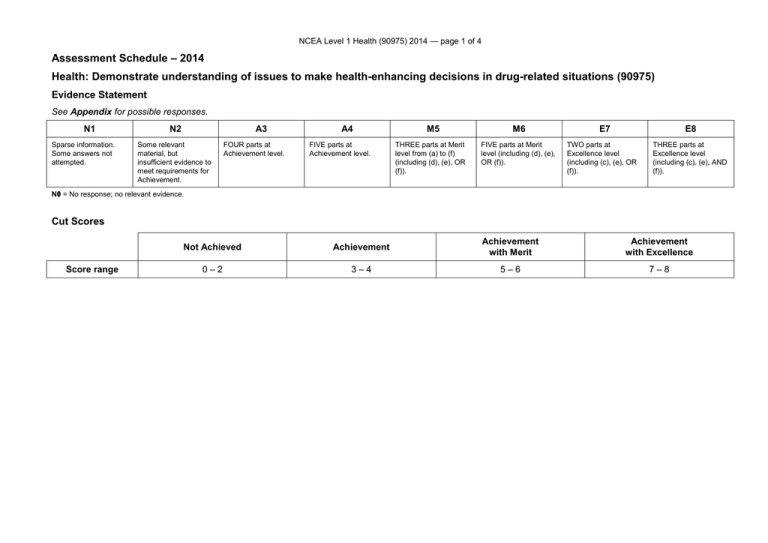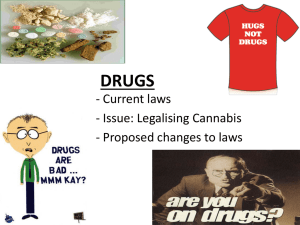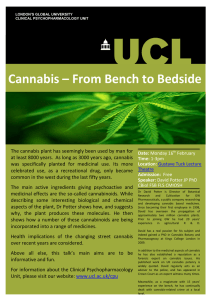– 2014 Assessment Schedule
advertisement

NCEA Level 1 Health (90975) 2014 — page 1 of 4 Assessment Schedule – 2014 Health: Demonstrate understanding of issues to make health-enhancing decisions in drug-related situations (90975) Evidence Statement See Appendix for possible responses. N1 Sparse information. Some answers not attempted. N2 A3 Some relevant material, but insufficient evidence to meet requirements for Achievement. FOUR parts at Achievement level. A4 FIVE parts at Achievement level. M5 THREE parts at Merit level from (a) to (f) (including (d), (e), OR (f)). M6 FIVE parts at Merit level (including (d), (e), OR (f)). E7 E8 TWO parts at Excellence level (including (c), (e), OR (f)). THREE parts at Excellence level (including (c), (e), AND (f)). N0/ = No response; no relevant evidence. Cut Scores Score range Not Achieved Achievement Achievement with Merit Achievement with Excellence 0–2 3–4 5–6 7–8 NCEA Level 1 Health (90975) 2014 — page 2 of 4 Appendix Question (a) Possible evidence (not limited to these examples) One personal, one interpersonal, AND one societal influence on Tatiana’s decision about whether or not she will drink alcohol at the party, eg: Personal influences could include: - Tatiana’s thoughts and opinions towards underage alcohol consumption. - Her knowledge and understanding of the effects of alcohol and previous experiences. Interpersonal influences could include: - Peer pressure from the other adolescents at the party (Tatiana wants to fit in with her peers). Societal influences could include: - The binge drinking culture in New Zealand. - The law around underage drinking and express consent. - Advertising, social media, and role models that all portray images and ideas around the consumption of alcohol. (b) (i) THREE different decisions Tatiana could make once she arrives at the party, eg: (1) To stay at the party and not drink. (2) To stay at the party and drink. (3) To leave the party as she feels the pressure to drink. (ii) The most health-enhancing decision selected from those identified in (i) for Tatiana, eg: To stay at the party and not drink. (iii) Why the selected decision in (ii) is the most health-enhancing for Tatiana, eg: To stay at the party and not drink would be the most health-enhancing for Tatiana as she would learn that she could socialise with her peers and enjoy herself without having to consume alcohol illegally. She would feel proud of herself for sticking with her decision not to drink despite being surrounded by her peers who are possibly drinking. Tatiana would feel happy with herself, as she would have proven to her parents that she could act responsibly in the presence of alcohol. The relationship between Tatiana and her parents would be strengthened, and so her parents would feel more confident in letting Tatiana attend other parties where alcohol is being served. NCEA Level 1 Health (90975) 2014 — page 3 of 4 (c) (i) THREE actions Mike’s parents need to take if they are going to serve alcohol legally at the 18th birthday party (ie in accordance with the recent law change), eg: (1) Gain express consent from the parent / guardian of each adolsecent attending the party. (2) Supply food and non-alcoholic drinks. (3) Arrange safe transport home. (ii) How EACH of the three actions in combination would be health-enhancing for those attending the party, eg: The action of gaining express consent from the parent / guardian of each adolescent attending the party would be health-enhancing because the parents of each adolescent would know where their child was and what they were up to. This would promote positive relationships between the adolescent and their parents / caregivers as they would have built up an element of trust when it comes to attending parties. If the adolescent did not have consent from their parents / caregivers to attend, it would mean the adolescent would not be allowed at the party, and this would reduce the risk of parties that get out of hand, ie people arriving without invitations. Often parties like this result in damage to property and binge drinking by adolescents, who then make poor decisions and are involved in risk-taking behaviour such as arguments with friends, physical fights, and unprotected sex. Poor decisions such as these often result in regret the following day and can lead to the loss of peer relationships, injuries, STIs, and unwanted teenage pregnancies. (d) The possible negative effects of cannabis on an individual’s overall well-being, eg: Brain damage, which could result in a range of mental health issues; loss of control over physical actions; loss of attention span, eg when driving (may lead to crashes). Mental health impacts such as a decline in IQ, depression, psychosis, schizophrenia. Loss of relationships with friends / family as they don’t agree with cannabis use; individual using may isolate themselves from others. Change in values / morals; the individual’s focus is on cannabis use; may feel reduced satisfaction with life, as goals are limited. NCEA Level 1 Health (90975) 2014 — page 4 of 4 (e) The potentially harmful effects of cannabis on interpersonal relationships, and on New Zealand society as a whole, eg: Poor role modelling to others, which may influence others to try cannabis, exposing them to the harmful effects of the drug; poor decisions that go against family values; trust issues with family / friends; changes in character, eg schizophrenic behaviours that could be detrimental to relationships. Social costs, eg road deaths, damage to others / community property, trouble with the police (resulting in costs to the taxpayer and convictions), hospital / health care for mental health issues. (f) A health-enhancing societal strategy that could be implemented to make people more aware of the potentially harmful effects of cannabis, justified by considering the personal, interpersonal, and societal implications of drug use, eg: Societal strategies could include: - Health teachers in local schools could educate their students about the harmful effects of cannabis (within classes or as full school presentations). - The local community constable could visit the schools in the area to present the harmful effects of cannabis to students. - Drug education speakers could visit schools to present the harmful effects of cannabis to students. - Advertising through posters in the community, television, websites, social media, etc, could warn of the harmful effects of cannabis. Implementing a health-enhancing societal strategy increasing people’s knowledge of the harmful effects of cannabis could reduce the use of the drug. More awareness of the harmful effects would allow individuals to make an informed choice not to use it. There would be less damage to the physical well-being of people (such as brain damage, lung problems, mental health issues, etc). Relationships would not suffer because of cannabis use, and less unsafe behaviours would be demonstrated, resulting in a reduction of damage to others / community property. With fewer people in society using cannabis, there would not be as many police convictions, and therefore a reduction in the cost to taxpayers.



